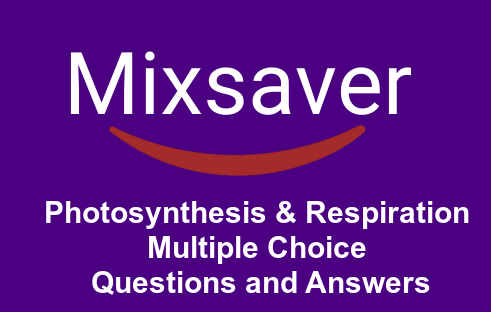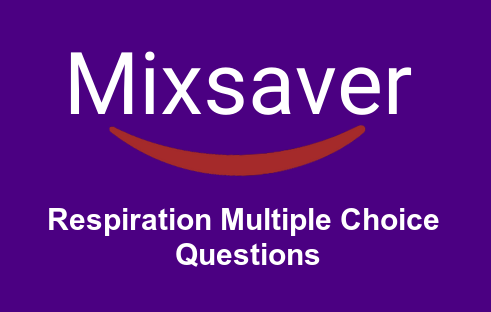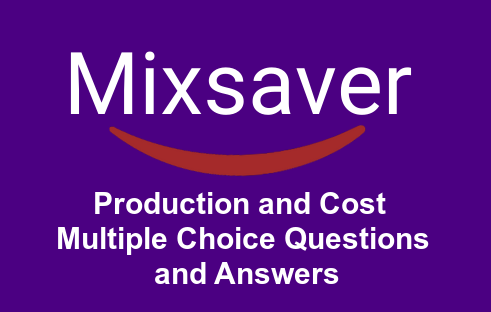Photosynthesis mcq pdf | MCQ on Respiration
1 For each glucose molecule that is broken down in glycolysis there is a net grain of
(a) 1 ATP molecule
(b) 2 ATP molecules
(c) 3 ATP molecules
(d) 4 ATP molecules
Ans. b
2. Which of the following enzymes catalyses a non-reversible reaction in glycolysis?
(a) Phosphofructokinase
(b) Enolase
(c) Triose phosphate isomerase
(d) Phosphohexose isomerase
Ans. a
3. Glucose-6-phosphate inhibits which of the following enzymes?
(a) Hexokinase
(b) Glucokinase
(c) Phosphorylasekinase
(d) Fructose-1, 6-bisphosphatase
Ans. a
4. The end product of fermentation of molasses by yeast is
(a) pyruvate
(b) ethyl alcohol
(c) lactate
(d) methyl alcohol
Ans. b
5. The oxidation of 1 mol of glucose by anaerobic glycolysis yield a net of
(a) 2 mol of acetyl Co-A and 2 mole of ATP
(b) 2 mol of lactate and 2 mol of ATP
(c) 2 mol of lactate, 2 mol of NAD* and 6 mole of ATP
(d) 2 mole of lactate, 2 mol of NADH and 2 mol of ATP
Ans. b
6. Glucokinase is characterised as
(a) it has a much higher Michaelis constant for glucose than hexokinase
(b) it is an allosteric enzyme
(c) it is found in most cells
(d) it phosphorylates most hexoses
Ans. a
7. Fluoride inhibits which glycolytic enzyme
(a) enolase
(b) glucokinase
(c) phosphofructokinase
(d) lactate dehydrogenase
Ans. a
8. Iodoacetate inhibits which glycolytic enzyme
(a) hexokinase
(b) enolase
(c) glyceraldehyde-3-phosphate dehydrogenase
(d) phosphoglycerate kinase
Ans. c
Respiration mcqs with answers | multiple choice questions on Photosynthesis with answers
9. Glycolysis occurs
(a) mitochondria
(b) cytosol
(c) Both (a) and (b)
(d) nucleus
Ans. b
10. Which enzyme is not present in muscle?
(a) Hexokinase
(b) Glucose-6-phosphatase
(c) Glycogen synthase
(d) Phosphorylase-b
Ans. b
11. Which glycolytic enzyme is used in gluconeogenesis?
(a) Pyruvatekinase
(b) Glucokinase
(c) Aldolase
(d) Phosphoglycerate kinase
Ans. d
12. Which enzyme cleaves C-C bond in glycolysis?
(a) Aldolase
(b) Enolase
(c) Phosphoglyceratekinase
(d) Phosphoglyceratemutase
Ans. a
13. Which enzyme is inhibited by arsenate?
(a) Glyceraldehyde-3 phosphate dehydrogenase
(b) Lactate dehydrogenase
(c) Hexokinase
(d) Phosphofructokinase
Ans. a
14. An embryo with complete deficiency of pyruvatekinase, how many net moles of ATP would be generated in conversion of one mole of glucose to one mole of pyruvate?
(a) 0
(b) 1
(d) 3
(c) 2
Ans. a
15. Malonate is an inhibitor of
(a) citrate synthase
(b) aconitase
(c) succinate dehydrogenase
(d) malate dehydrogenase
Ans. c
16. Which enzyme in TCA cycle is involved in formation of GTP from GDP?
(a) Succinate dehydrogenase
(b) Malate dehydrogenase
(c) Citrate synthase
(d) Succinate thiokinase
Ans. d
17. Which vitamin is required for the synthesis of co-factor, required in conversion of succinate to fumarate?
(a) Riboflavin
(b) Thiamine
(c) Lipoic acid
(d) Niacin
Ans. a
18. Which of the following is utilised as precursor for cholesterol biosynthesis?
(a) Succinyl Co-A
(b) Acetyl Co-A
(c) Succinate
(d) Malate
Ans. b
19. How many molecules of CO, are produced per mole of acetyl Co-A in TCA cycle?
(a) 2
(b) 1
(c) 3
(d) 4
Ans. a
20. Which of the following is a component of succinate dehydrogenase in an electron transport chain?
(a) Niacin
(b) FMN
(c) FAD
(d) Co-enzyme-Q
Ans. c
21. Which of the following ETC components accepts only one electron?
(a) Cytochrome-b
(b) Oxygen
(c) FAD
(d) FMN
Ans. a
22. Which of the following enzymes catalyses the conversion of hydrogen peroxide to water?
(a) Hydratase
(b) Catalase
(c) Dioxygenase
(d) Dismutase
Ans. b
mcq on photosynthesis class 10 | mcq on light reaction of photosynthesis | multiple choice questions on respiration
23. Which process does not involve cytochrome-c?
(a) Apoptosis
(b) TCA cycle
(c) Electron transport
(d) Oxidative phosphorylation
Ans. b
24. Light reaction is dependent on light and produce
(a) ATP
(b) NADPH
(c) Both (a) and (b)
(d) None of these
Ans. c
25. Which of the following pigments is found in the reaction centre?
(a) Phycobilins
(b) Chlorophyll
(c) Carotenoids
(d) All of these
Ans. b
26. The wavelength absorbed by chlorophyll-a is
(a) 430
(b) 660
(c) Both (a) and (b)
(d) None of these
Ans. c
27. Non-cyclic photophosphorylation utilise which of the following?
(a) Only PS-I
(b) Only PS-I
(c) Both PS-I and PS-II
(d) None of these
Ans. a
photosynthesis mcq for neet pdf | mcqs on photosynthesis in higher plants
28. Which of the following ion is involved in ATP synthesis?
(a) Ca 2+
(b) Zn2+
(c) CI-
(d) H+
Ans. d
29. During photosynthesis, which process releases electrons that return chlorophyll molecules to their reduced state?
(a) Nutrition of photosystem-l
(b) Oxidation of reduced NADP
(c) Phosphorylation of ADP
(d) Photolysis of water
Ans. d
30. Which statement is correct about compensation point?
(a) No, growth occurs
(b) Rate of photosynthesis is equal to respiration
(c) Neither O, nor CO, is given off
(d) Occurs, when light intensity falls to 20% of normal
Ans. b
31. PS-II is not concerned with
(a) photolysis of water
(b) flowering
(c) reduction of CO2
(d) release of energy
Ans. b
32. Agranal chloroplasts are characteristics of
(a) mesophyll of pea leaves
(b) bundle sheath of mango leaves
(c) mesophyll of maize leaves
(d) bundle sheath of sugarcane leaves
Ans. d
33. If intensity of light increases 20 times, the rate of photosynthesis will
(a) increase
(b) constant
(c) decrease
(d) increase till feed back inhibition
Ans. d
34. Which of the following is essential for the process of photosynthesis?
(a) Carbohydrates and oxygen
(b) Water, minerals and CO2
(c) Light, chlorophyll and optimum temperature
(d) Both (b) and (c)
Ans. d
35. Chloroplast contains the maximum concentration which of the following? ion 51.
(a) Starch
(b) Fructose
(c) 3-PGA
(d) RUBP carboxylase
Ans. d
36. All photosynthetic green plants contain
(a) chlorophyll-a
(b) chlorophyll-b
(c) chlorophyll- c
(d) chlorophyll-e
Ans. a
37. Photo centres in higher plants are
(a) P700
(b) P680
(c) Both (a) and (b)
(d) Chlorophyl-a
Ans. c
38. Which of the following is most effective in photosynthesis?
(a) Blue light
(b) Green light
(c) Red light
(d) Yellow light
Ans. c
39. Chlorophyll contains
(a) Fe
(b) Mg
(c) K
(d) Mn
Ans. b
40. The number of oxygen molecules produced per quantum of light absorbed is
(a) oxygen yield
(b) photosynthesis yield
(c) quantum yield
(d) organic yield
Ans. b





